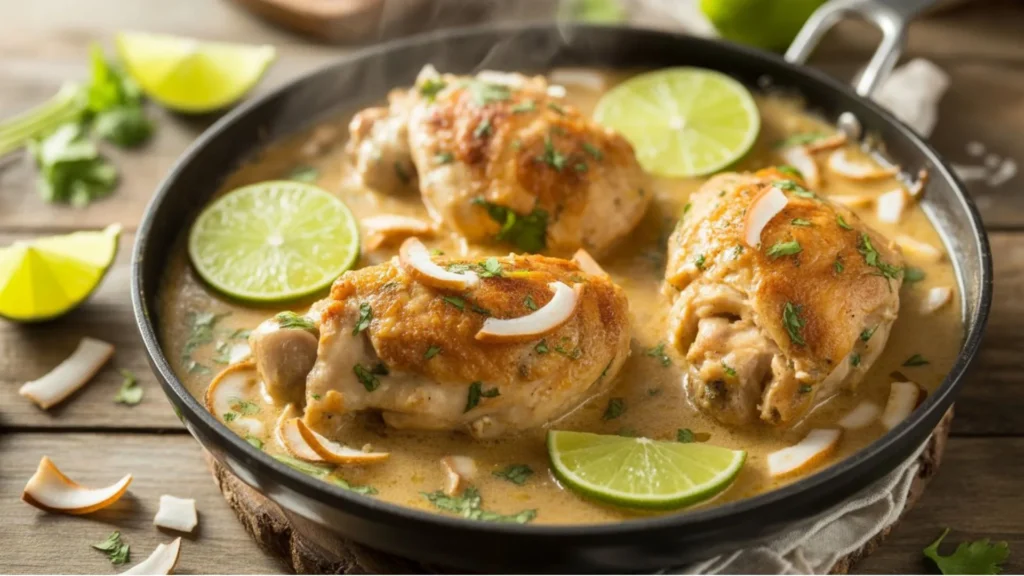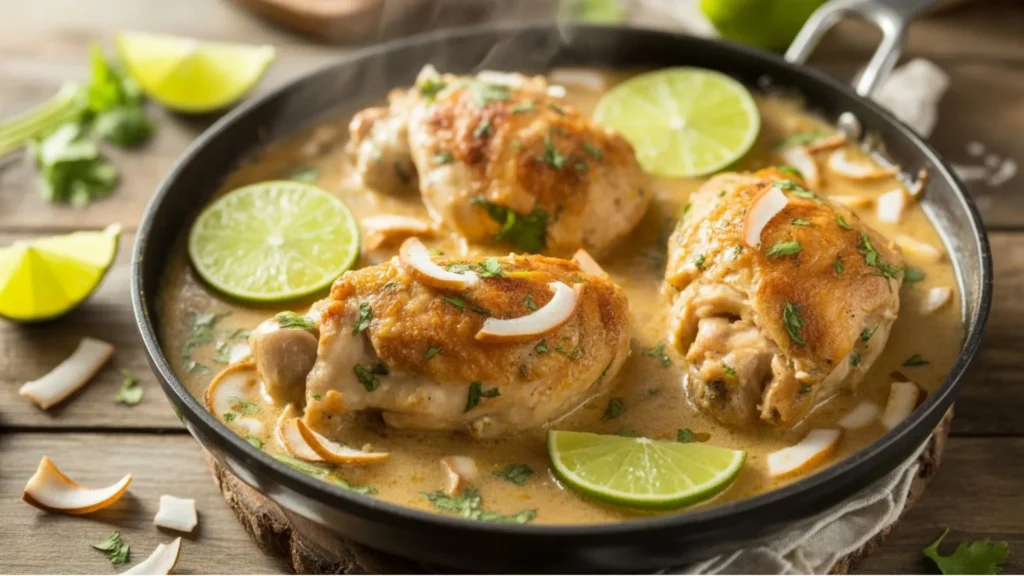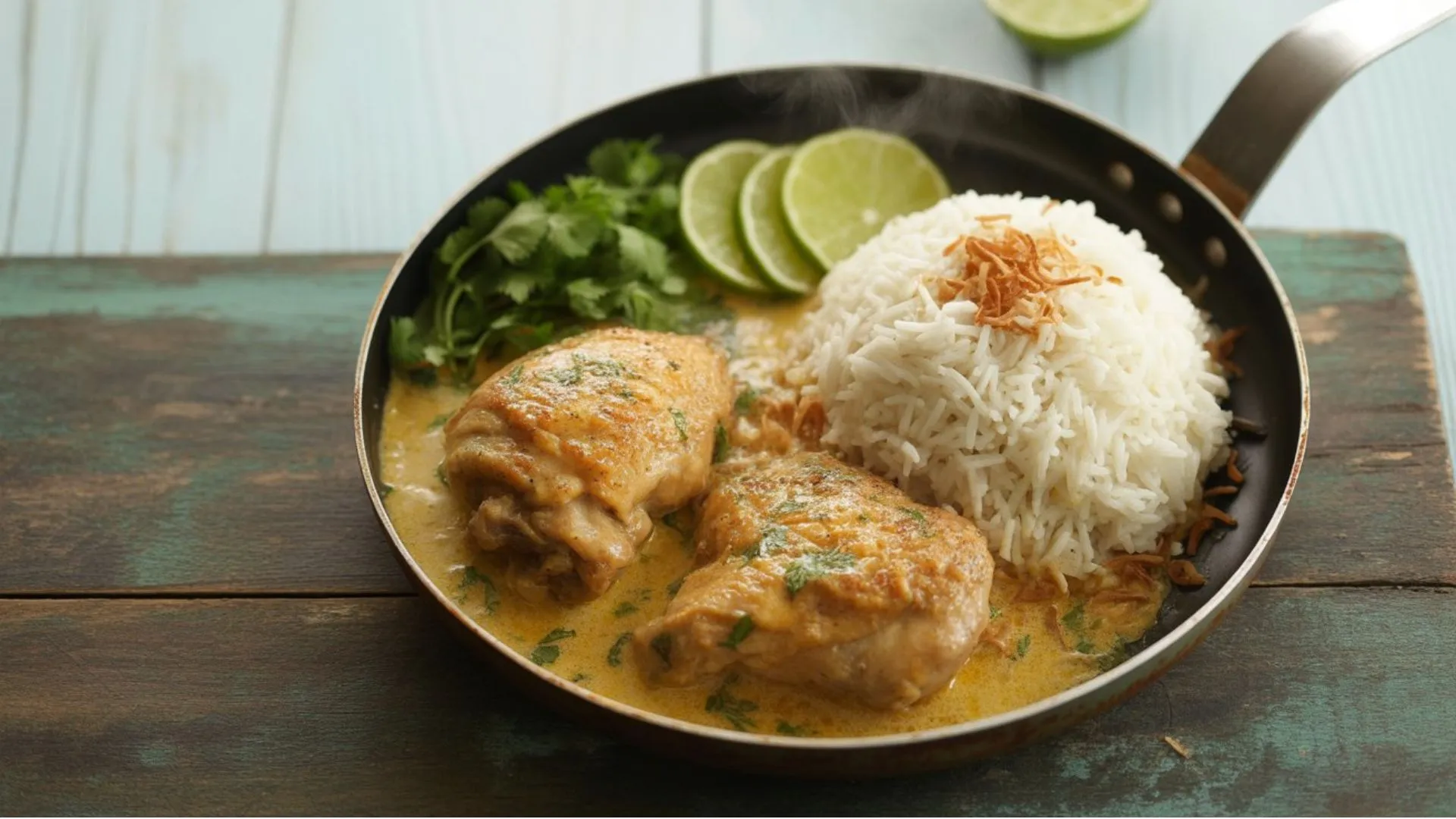Table of Contents
One Pan Coconut Lime Chicken: Transform Your Evening Routine
It’s 6 PM on a Tuesday, you’ve just walked through the door after a long day, and your family is asking “What’s for dinner?” Your energy is depleted, but you still want to serve something delicious and nutritious. This is where one pan coconut lime chicken becomes your weeknight hero.
I remember the first time I discovered this game-changing recipe during one of those overwhelming weeks when takeout felt like the only option. The aromatic blend of creamy coconut milk and zesty lime transported my kitchen into a tropical paradise, while the simple one-pan method meant minimal cleanup. Within 30 minutes, my family was enjoying restaurant-quality flavors without the stress, expense, or lengthy preparation. This dish didn’t just feed us—it restored my confidence in weeknight cooking and proved that extraordinary meals can emerge from the simplest approaches.
Many home cooks have embraced this coconut lime chicken approach for its versatility and foolproof results. The beauty lies in its adaptability—you can customize ingredients based on what’s available in your refrigerator while maintaining those signature tropical flavors that make this dish special.
Why One Pan Coconut Lime Chicken Is Your Weeknight Game-Changer
The Science Behind One-Pan Success
When you choose one-pan cooking methods, you’re embracing efficiency without sacrificing flavor. Fewer dishes mean less cleanup stress, allowing you to focus on what matters most—spending time with your family. The even heat distribution in a single pan creates perfectly cooked proteins and vegetables simultaneously, while flavor compounds meld together naturally for enhanced taste profiles.
This time-efficient cooking method reduces kitchen overwhelm, transforming your evening routine from chaotic to calm. You’ll discover that cooking in one vessel allows ingredients to share their essences, creating depth that’s impossible to achieve when components cook separately.
Nutritional Benefits That Matter
Your one pan coconut lime chicken delivers impressive nutritional value alongside convenience. High-quality protein from chicken supports muscle health and keeps you satisfied longer. Coconut milk provides healthy medium-chain triglycerides that your body easily converts to energy, while fresh lime adds vitamin C and enhances mineral absorption from other ingredients.
The customizable vegetables you incorporate increase fiber content and deliver essential micronutrients your family needs. Unlike processed convenience foods, this homemade approach gives you complete control over sodium levels, preservatives, and ingredient quality.
Budget-Friendly Family Feeding
Your cost per serving averages $3-4 compared to $12+ restaurant meals, making this recipe incredibly economical. You’ll use affordable pantry staples and seasonal produce, creating meals that scale easily for meal prep or larger families. The efficient ingredient utilization reduces food waste, stretching your grocery budget further while delivering superior nutrition.

Essential Ingredients for Perfect One Pan Coconut Lime Chicken
Protein Foundation
Boneless, skinless chicken thighs serve as your optimal protein choice. Two pounds provides generous portions while maintaining moisture throughout cooking. Unlike chicken breasts, thighs resist overcooking and deliver richer flavor. However, you can substitute chicken breasts, shrimp, or tofu based on dietary preferences or availability.
Coconut Lime Flavor Base
Your flavor foundation begins with full-fat coconut milk (one 13.5 oz can) for rich, creamy texture. Light coconut milk works in pinch situations, but full-fat varieties create the luxurious sauce that makes this dish special. Fresh lime juice from 3-4 limes provides optimal acidity balance, while lime zest from 2 limes contributes aromatic oils that elevate the entire dish.
Unsweetened coconut flakes (¼ cup) add textural contrast and reinforce the tropical theme without overwhelming sweetness.
Aromatic Building Blocks
Your aromatic foundation requires fresh garlic (4-5 cloves, minced), fresh ginger (1-inch piece, grated), and yellow onion (1 medium, diced). These ingredients create the flavor base that transforms simple coconut milk into restaurant-quality sauce. Fresh cilantro (½ cup chopped) serves as your finishing garnish, adding bright herbaceous notes.
Vegetable Medley Options
Bell peppers (2 cups sliced in any color combination) provide sweetness and vibrant color. Snap peas (1 cup) contribute satisfying crunch, while baby potatoes (1 pound, halved) create hearty substance. Broccoli florets (2 cups) boost nutritional content and add appealing green color to your finished dish.
Pantry Seasonings
Coconut oil (2 tablespoons) serves as your cooking fat, complementing the coconut theme. Sea salt (1 teaspoon), freshly ground black pepper (½ teaspoon), and optional red pepper flakes (¼ teaspoon) provide seasoning foundation. Fish sauce (1 tablespoon) adds umami depth that transforms good coconut lime chicken into extraordinary results.
Tip #1 – Master the Perfect Pan Selection and Setup
Choosing Your Weapon of Choice
Your foundation for exceptional one pan coconut lime chicken begins with proper cookware selection. A large, heavy-bottomed skillet or Dutch oven measuring 12-14 inches ensures adequate space for ingredients without overcrowding. Cast iron, stainless steel, or enameled cast iron work beautifully, while thin pans create hot spots that can burn delicate ingredients.
Pan Preparation Techniques
Begin by heating your pan over medium-high heat for 2-3 minutes before adding oil. This preheating protocol ensures even cooking from the start. Swirl coconut oil to coat the entire surface evenly, watching for the shimmer that indicates proper temperature. Your oil should glisten but never smoke, which signals overheating that can create bitter flavors.
Ingredient Arrangement Strategy
Arrange chicken pieces with space between each portion, avoiding overcrowding that leads to steaming instead of searing. Add heartier vegetables first, saving delicate ones for later additions. Pour coconut milk around chicken pieces rather than directly over them, maintaining the seared surfaces you’ve worked to create.
Heat Management Keys
Start with high heat for protein browning (3-4 minutes per side), then reduce to medium-low for gentle simmering. This technique develops complex flavors while preventing overcooking. Increase heat briefly during final minutes to thicken your sauce naturally through reduction.
Tip #2 – Timing Sequence for Restaurant-Quality Results
Phase One: Protein Preparation (5 minutes prep, 4 minutes cooking)
Season your chicken generously with salt and pepper 15 minutes before cooking, allowing time for seasoning penetration. Pat chicken completely dry with paper towels—moisture prevents proper browning. Sear chicken pieces until golden brown on both sides, then remove temporarily to prevent overcooking during sauce development.
Phase Two: Aromatic Foundation (3 minutes prep, 5 minutes cooking)
Sauté onions in the same pan until translucent (approximately 3 minutes), building flavor layers in your fond. Add garlic and ginger, cooking until fragrant (1 minute maximum—longer cooking creates bitterness). Incorporate harder vegetables like potatoes or carrots now, as they require extended cooking time.
Phase Three: Sauce Development (2 minutes prep, 10 minutes cooking)
Pour coconut milk gradually while stirring continuously, preventing separation or curdling. Add lime juice and zest for brightness, then return chicken to pan, nestling pieces into developing sauce. Simmer uncovered to concentrate flavors naturally, adding delicate vegetables during final 5 minutes.
Phase Four: Final Assembly (5 minutes)
Taste and adjust seasoning balance carefully—you can always add more lime or salt, but you cannot remove excess. Garnish with fresh cilantro and lime wedges, then rest briefly before serving to allow flavor integration.
Tip #3 – Five Irresistible One Pan Coconut Lime Chicken Variations
Classic Weeknight Version
Your traditional approach combines 2 lbs cubed chicken thighs with coconut milk, fresh lime juice and zest, garlic, onion, and colorful bell peppers. This version delivers consistent results every time, perfect for weeknight reliability.
Total Time: 30 minutes (10 minutes prep, 20 minutes cooking)
Thai-Inspired Elevation
Transform your basic recipe by incorporating Thai red chilies, fish sauce, and Thai basil leaves. These additions create authentic Southeast Asian flavors that transport your dining room to Bangkok street markets. For additional inspiration on one pan coconut lime chicken variations, explore different regional approaches that maintain the core tropical theme.
Total Time: 30 minutes (12 minutes prep, 18 minutes cooking)
Veggie-Loaded Powerhouse
Pack extra nutrition by including snap peas, broccoli florets, baby potatoes, and sliced carrots. This variation satisfies vegetable requirements while maintaining protein focus.
Total Time: 40 minutes (15 minutes prep, 25 minutes cooking)
Heat-Lover’s Delight
Satisfy spice enthusiasts with jalapeños and cayenne pepper additions. Control heat levels by adjusting quantities and removing jalapeño seeds for milder results.
Meal Prep Champion
Double your recipe quantities for 8 servings, cooking rice separately for serving bases. Store components separately for optimal freshness, reheating gently with additional coconut milk when needed.
Tip #4 – Troubleshooting Common Mistakes
Preventing Curdled Coconut Milk
Never boil coconut milk vigorously—gentle simmering preserves smooth texture. Add liquid slowly while stirring continuously, and if separation occurs, whisk vigorously to re-emulsify your sauce.
Avoiding Dry, Overcooked Chicken
Use thighs instead of breasts for natural moisture retention. Cook to 165°F internal temperature without exceeding this target. Allow 5 minutes resting period before serving to redistribute juices throughout meat.
Balancing Lime Intensity
Add lime juice incrementally, tasting frequently to prevent overpowering sourness. Include zest during final minutes to preserve essential oils, and counter excess acidity with coconut cream if needed.
Achieving Proper Sauce Consistency
Simmer uncovered to reduce liquid naturally, or create cornstarch slurry (1 tablespoon cornstarch mixed with cold water) for quick thickening. Finish with 2-3 tablespoons coconut cream for luxurious richness.
Tip #5 – Meal Planning and Storage Strategies
Weekly Integration
Prepare double portions for efficient meal planning, storing proteins, vegetables, and sauce separately to maintain optimal textures. When reheating, add coconut milk splash to restore creaminess.
Storage Guidelines
Refrigerate up to 4 days in airtight containers, or freeze for 3 months after cooling completely. Divide into single-serving containers for convenient portion control.
Leftover Transformations
Serve cold over mixed greens for coconut lime chicken salad, reheat with eggs for breakfast hash, or thin with additional coconut milk and broth for soup conversion.

Conclusion
Your journey to weeknight dinner success begins with mastering one pan coconut lime chicken. These five essential tips—proper pan setup, precise timing, creative variations, mistake prevention, and smart meal planning—guarantee restaurant-quality results in 30 minutes or less. The versatility of this dish accommodates dietary preferences, seasonal ingredients, and family schedules while delivering satisfying flavors with minimal cleanup.
Ready to transform your weeknight routine? Start with the classic version tonight, then experiment with variations throughout the week. Your family will thank you, your schedule will benefit, and your confidence in the kitchen will soar. Share your favorite variation in the comments below and inspire other busy families to embrace stress-free, delicious weeknight cooking.
FAQ About One Pan Coconut Lime Chicken
Can I make one pan coconut lime chicken with chicken breasts?
Yes, but reduce cooking time to 12-15 minutes and monitor internal temperature closely to prevent drying out.
What’s the best coconut milk for this recipe?
Full-fat canned coconut milk provides optimal richness and texture, though light versions work for dietary restrictions.
How do I prevent excessive sourness?
Add lime juice gradually while tasting, balancing acidity with coconut cream or pinch of sugar if needed.
Is this recipe suitable for meal prep?
Absolutely! Store refrigerated for 4 days or frozen for 3 months, reheating gently with additional coconut milk.
Which vegetables complement coconut lime chicken best?
Bell peppers, snap peas, broccoli, and baby potatoes work beautifully, adding harder vegetables early and softer ones near completion.
Have You Given This Recipe A Try?
There are no reviews yet. Be the first one to write one.

